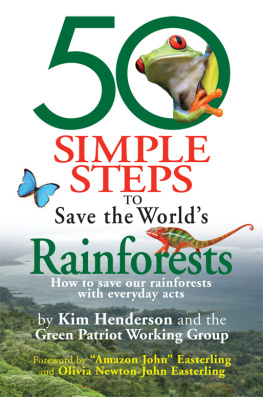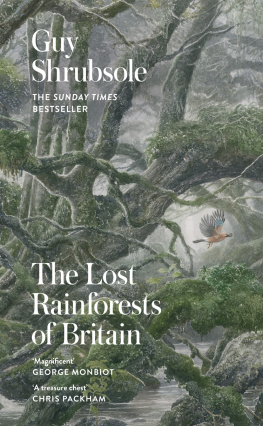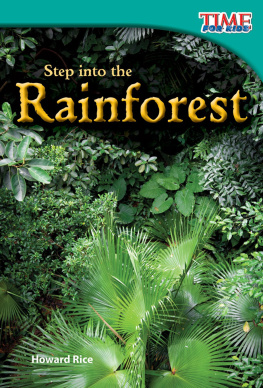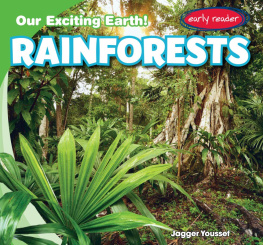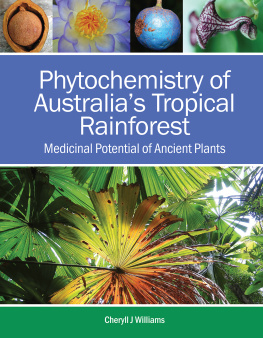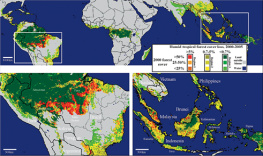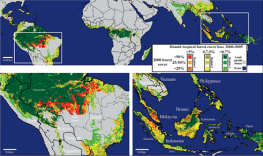ABOUT THE TROPICAL RAINFOREST
While all ecosystems play an important role in the health of our planet, there is none more impactful or more threatened than tropical rainforeststhe richest and most biodiverse ecosystem on earth. At one time, a few thousand years ago, tropical rainforests covered approximately 12 percent of the Earths land surface, but today less than 5 percent remainsand its growing smaller everyday. Although difficult to determine and often debated, an estimated 80,000 acres of rainforest are lost every 24 hours with another 80,000 acres degraded, reports Mongabay.com.
You might think that the rainforest has very little to do with your daily living, but as we discovered, that is far from the truth. Here in the United States and in Europe, we are surprisingly dependent on products and resources from the rainforest, and our consumption of these commodities is having a major impact on tropical ecosystems as well as indigenous people all over the globe. One of the goals of this book is to illuminate the major areas of consumer impact to the rainforest, both destructive and beneficial, so that you are personally empowered to make rainforest-saving choices in the way you shop and live. We have also created steps designed to strengthen the spiritual connection we all share to the rainforest. And of course, we had to include some good old environmental activist steps for those who have the time and inclination to get more involved and committed to the cause.
But before we get started, lets take a look at where the remaining tropical rainforests are located, why saving them is vital to the planet and the survival of mankind, and what forces are destroying them.
WHERE ARE THE TROPICAL RAINFORESTS LOCATED?
Tropical rainforests are located between the Tropics of Cancer and Capricorn in the worlds equatorial regions and are found in Mexico, Central America, South America, West Africa, tropical Asia, the tropical Pacific Islands and Australia. About one-third of the worlds tropical forest is found in the Amazon, the largest rainforest on Earth. The Amazon River Basin spans eight South American countries (Brazil, Peru, Colombia, Bolivia, Ecuador, Venezuela, Guyana and Suriname) as well as French Guiana, a department of France. More than half the Amazon lies in Brazil. The Congo Basin is the worlds second-largest tropical rainforest, occupying about 18 percent of the earths tropical forest cover. The Congo spans six countriesCameroon, the Central African Republic, the Republic of the Congo, the Democratic Republic of the Congo, Equatorial Guinea and Gabon. After the Congo, Indonesia has the next greatest amount of tropical forest cover and the most extensive in all of Asia. Its 17,000-island archipelago spans the Indomalayan and Australiasian biogeographic realms. The balance of the worlds rainforests are scattered across the globe in tropical regions.

WHY SHOULD WE SAVE THE RAINFORESTS?
There are many good reasons to save tropical rainforests. Here are the ones that are most critical to our survival.
Biodiversity
Tropical rainforests are literally overflowing with life and biodiversity. Twelve hours of intense sunlight daily and 80 inches or more of rain each year infuse the jungle with energy, making it the most biodiverse ecosystem, containing a whopping 50 percent of all the plants and animals on Earth. The Rainforest Action Network reports that a typical four-square-mile patch of rainforest contains as many as 1,500 flowering plants, 750 species of trees, 400 species of birds and 150 species of butterflies. In fact, new species of insects, plants and animals are still being discovered. And conversely, as rainforest is lost, species science has yet to discover are also lostan estimated 100 species or more each day, according to the World Resources Institute.
Living Pharmacopoeia
As John and Olivia mentioned in our foreword, rainforests are a powerhouse of medicinal botanicals. Many of the prescription drugs used in the Western world have been derived from tropical plants. In fact, 70 percent of the plants identified by the U.S. National Cancer Institute as having anti-cancer characteristics are found only in tropical forests. So far, less than 3 percent of tropical rainforest species have been analyzed for their medicinal value. Imagine what has yet to be discovered.
Climate Stabilization
Tropical rainforests do the world a double service by both absorbing carbon dioxide, a greenhouse gas, and producing oxygen. Acting as the lungs of the planet, rainforests produce a significant amount of the worlds oxygen through photosynthesis, which allows mammals, including us humans, to thrive. According to Mongabay.com, some scientists estimate the amount of the Earths oxygen produced by the rainforests to be 20 percent. As scientists indicate, climate change is largely the result of excess carbon dioxide emissions from human activities. Tropical rainforests act as carbon sinks. However, when they are destroyed, all that stored carbon is released into the atmosphere, making deforestation a gargantuan liability. According to the Intergovernmental Panel on Climate Change, a full 17 percent of carbon emissions comes from deforestation, and surprisingly, that figure is higher than the entire travel sector!
Water Cycle and Weather Patterns
Speaking of climate, tropical rainforests play a critical role in the worlds weather patterns and available water supply. One-fifth of the worlds fresh water supply is held in the Amazon Basin. Through a process of transpiration in which plants release water from their leaves during photosynthesis, tropical rainforests add water to the atmosphere. The moisture then contributes to the formation of clouds, which release water back into the rainforest. Mongabay.com reports that in the western Amazon, 50 to 80 percent of moisture remains in the ecosystems water cycle. Yet when deforestation occurs, water does not transpire back into cloud formation fallen rain simply washes into streams and out to the ocean and is lost forever. This contributes to droughts, and it can lead to permanent drying.
The rainforest water cycle affects areas outside the equatorial regionsfar into the Northern Hemisphere, according to a NASA study published in the April 2005 Journal of Hydrometeorology. Researchers examined the effects of tropical forest loss on precipitation patterns around the globe. The study found that deforestation in the Amazon influences rainfall from Mexico to Texas and into the Gulf of Mexico. Central African forest loss affects precipitation in the U.S. Midwest. Southeast Asian forest loss impacts precipitation in China and the Balkan Peninsula. And deforestation of any of these tropical forestsAmazonia, Central Africa or Southeast Asia"considerably enhances rainfall in the southern tip of the Arabian Peninsula. Surprisingly, the effect of forest loss in all three regions combined causes rainfall decline in California during the winter season and further increases precipitation in the southern tip of the Arabian Peninsula.
Another study published in 2009 in the Journal of Climate simulated the effects of Amazon deforestation on global ocean and atmospheric patterns and found that the reduction of precipitation due to forest loss would cause significant changes and variability, like what we see currently with El Nino.
The main point here is that what happens in the rainforest doesnt stay in the rainforestit affects precipitation patterns all over the world, which, certainly in the case of California, could seriously affect world grain and produce supplies.
Erosion Protection
One other critical function rainforest serves, particularly on hillsides, is that it anchors the soil. With so much precipitation, if rainforest is not present securing soil in place, it quickly erodes and washes away into rivers, where it changes the ecosystem. Clouded water and silt-filled spawning grounds affect fish populations, and as more sediment fills riverbeds, the shallower waters make them more difficult to navigate by boat. Even worse, in hilly areas, deforestation makes deadly landslides more likely.
Next page
